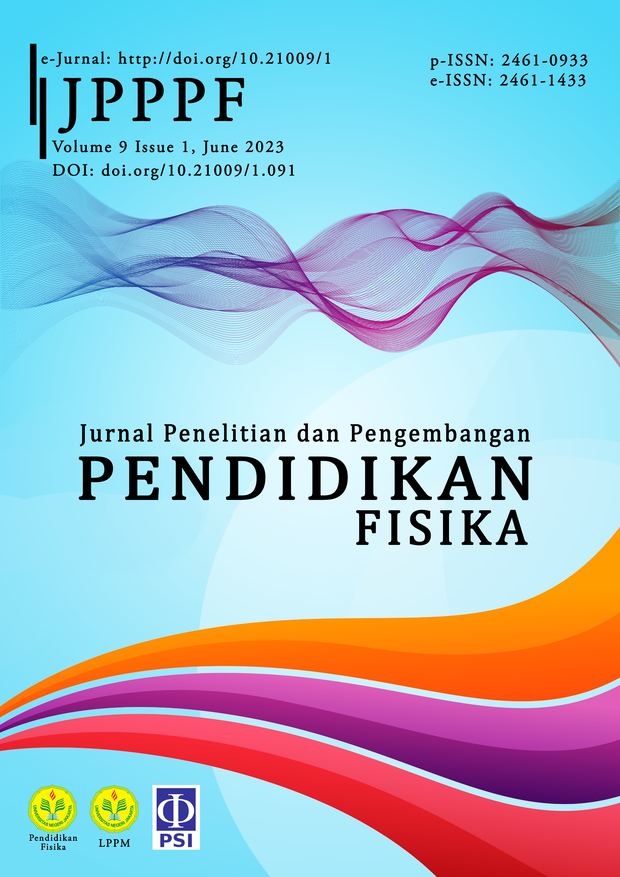The Effectiveness of Using the Minnesota Model in Completing University Physics Selection Exam
DOI:
https://doi.org/10.21009/1.09107Keywords:
effectiveness, minnesota model, physics problemAbstract
This study raises the issue of whether the Minnesota model in solving university selection physics questions gets the right results in terms of answers and time. This research aims to determine the effectiveness of using the Minnesota problem-solving model for the accuracy of answers and time in solving physics problems. The type of research is quantitative research with experimental methods. The population of this study was students of class XI from senior high school in Banda Aceh. The sample in this study was two classes. There was the experimental class and control class. Determination of the sample is done by purposive sampling. The approach used is a quantitative approach with the type of experimental research. The data was collected using a written test technique and data processing using an analysis of the effectiveness of the accuracy of the answers using an assessment rubric that has been validated and using t-test statistics, as well as the effectiveness of the use of time analysis based on the average time use of the two classes. The results of the data analysis showed that the average value of the experimental class using the Minnesota problem-solving model was higher than the control class, and the experimental class’s time usage was faster than the control class. It was stated that the Minnesota problem-solving model was effectively used in solving physics problems.
References
Andriani, NLY, Darsikin & Hatibe, A 2016, ‘Analisis kesulitan siswa dalam menyelesaikan soal gerak lurus’, Jurnal Pendidikan Fisika Tadulako, vol. 4, no. 3, pp. 36-41.
Cho, MK & Kim, MK 2020, ‘Investigating elementary students‟ problem solving and teacher scaffolding in solving an ill-structured problem’, International Journal of Education in Mathematics, Science and Technology (IJEMST), vol. 8, no. 4, pp. 274-289.
Collette, AT & Chiappetta, EL 1994, ‘Science Instruction in the Middle and Secondary Schools (3rd edition)’, New York, Merrill.
Danim, S 2004, ‘Motivasi Kepemimpinan dan Efektivitas’, Bengkulu, PT Rineka Cipta.
Darvina, Y 2008, ‘Penyelesaian soal-soal Fisika menggunakan Minnesota Prroblem Solving Strategi (Universitas Negeri Padang’, skripsi seminar nasional (Online), Fakultas MIPA Jurusan Fisika (diakses 21 Maret 2022).
Druxes, H 1993, ‘Kompedium Didaktik Fisika’, Remaja Karya, Bandung.
Guntara, Y & Utami, SU 2021, ‘Implementation of Augmented Physics Animation Integrated Crosscutting Concept COVID 19 in Facilitating Problem Solving Skills and Disaster Preparedness’, Jurnal Penelitian dan Pengembangan Pendidikan Fisika, vol. 7, no. 1, pp. 43-51.
Heller, P & Hel1er, K 1994, ‘The Competent Problem Solver’, A Strategy for Solving Problems in Physics, University of Minnesota, Minnesota, vol. 116.
Krulik, S & Rudnick, JA 1993, ‘The New Sourcebook for Teaching Reasoning and problem Solving in Elementer School’, Allyn & Bacon A Simon & Schuster Company, Massachusetts.
Leigh, G 2004, ‘Developing Multi-representational Problem Solving Skills in Large, Mixed-ability Physics Classes’, Master’s thesis, University of Cape Town.
Liana et al. 2020, ‘The Development of Thermodynamics Law Experiment Media Based on IoT: Laboratory Activities Through Science Problem Solving for Gifted Young Scientists’, Jurnal Penelitian dan Pengembangan Pendidikan Fisika, vol. 6, no. 1, pp. 51-64.
Mahmudi 2010, ‘Manajemen Kinerja Sektor Publik’, STIE YKPN, Jakarta.
Merisa, NS, Halim, A, Mahzum, E 2020, ‘The Effects of Exercise Using Minnesota Strategy Problem Solving Model to Student Learning Outcomes and Critical Thinking Ability’, Asian Journal of Science Education, vol. 1, no. 2, pp. 24-32.
Miarso, Y 2004, ‘Menyemai Benih Teknologi Pendidikan’, Kencana, Jakarta.
Musdalifah 2017, ‘Analisis Kesulitan Siswa Dalam Menyelesaikan Soal- Soal Fisika Pada Materi Kalor Berdasarkan Teori Polya Di Kelas X Sman 2 Teluk Dalam’, Skripsi, UIN Ar-Raniry, Darussalam.
Nurhayati & angraeni 2017, ‘Analisis Kemampuan Berpikir Tingkat Tinggi Mahasiswa (Higher Order Thinking) dalam MenyelesaikanSoal Konsep Optika melalui Model Problem Based Learning’, Jurnal Penelitian dan Pengembangan Pendidikan Fisika, vol. 3, no. 2, pp. 119-126.
Pertiwi, CM, Muliati, D & Serevina, V 2016, ‘Rancangan Tes dan Evaluasi Fisika yang Informatif dan Komunikatif pada Materi Kinematika Gerak Lurus’, Jurnal Penelitian dan Pengembangan Pendidikan Fisika, vol. 2, no. 1, pp. 81-88.
Peter, EE 2012, ‘Critical thinking: Essence for teaching mathematics and mathematics problem solving skills’, African Journal of Mathematics and Computer Science Research, vol. 5, no. 3, pp. 39-43.
Prince, MJ & Felde, RM 2006, ‘Inductive Teaching and Learning Methods: Definitions, Comparisons, and Research Bases’, Journal of engineering education, vol. 95, no. 2, pp. 123-138.
Ruggiero, VR 2012, ‘Beyond Feelings A Guide to Critical Thinking, 9th ed, McGraw-Hill’, New York.
Schnotz, W 2002, ‘Commentary: Towards an integrated view of learning from text and visual displays’, Educational psychology review, vol. 14, no. 1, pp. 101-120.
Selvaratnan, M & Canagaratna 2008, ‘Problem-Solution Maps To Improve Students’ Problem Solving Skill’, Division of Chemical Education, vol. 85, pp. 381-384.
Snyder, LG & Snyder, MJ 2008, ‘Teaching Critical Thinking and Problem Solving Skills’, The Journal of Research in Business Education, vol. 50, no. 2, pp. 90-99.
Syukri 2015, ‘Model Pendekatan Pakar Fisika Dalam Menyelesaikan Masalah Fisika Kontekstual: Sebuah Studi Kasus’, Jurnal Pendidikan Fisika Indonesia, vol. 8, no. 1, pp. 61-67.
Thorne, A & Thomas, G 2009, ‘How to increase higher level thinking’, Center For Development and Learning, Metarie, LA.
Torres, NG & Constain, JJA 2009, ‘Improving Reading Comprehension Skills through Reading Strategies Used by a Group of Foreign Language Learners’, HOW, vol. 16, no. 1, pp. 55-70.
Toth, Z & Sebestyen 2009, ‘Relationship Between Students Knowledge Srtucture and Problem Solving Strategy in Stoichimetric Problem based on the Chemical Equation’, International Journal of Physics and Chemistry Education, vol. 1, no. 1, pp. 8-20.
Tumanggor et al. 2019, ‘The Profile of Students’ Physics Problem Solving Ability in Optical Instruments’, Jurnal Penelitian dan Pengembangan Pendidikan Fisika, vol. 5, no. 1, pp. 29-40.
Walle, JAVD 2008, ‘Matematika Sekolah Dasar dan Menengah Pengembangan Pengajaran’, Erlangga, Jakarta.
Young, HD & Freedman, RA 2012, ‘Sears and Zemansky’s University Physics – with Modern Physics (13th ed.)’, San Francisco: Pearson education.
Zeitz, P 2007, ‘The Art and Craft of Problem Solving’, John Wiley & Sons, Inc, New York.











